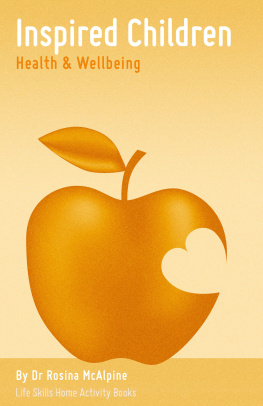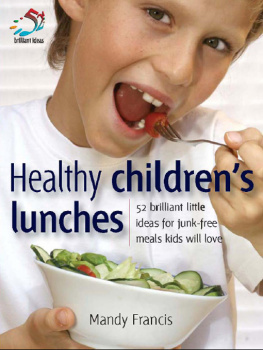Healthy Holidays
Healthy Life Kitchen
I Refuse to Raise a Brat
The 30-Day Total Health Makeover
Marilu Henners Total Health Makeover
By All Means Keep on Moving
To children everywhere
and their right to be healthy

Contents

S tarting a healthy lifestyle is not something you begin only after there is a problem. Proper diet and nutrition in early childhood are essential. A childs diet in the womb, during infancy, and as a toddler can have lifelong effects on his or her health. Researchers are showing that a babys food preference can be traced to the womb. For the first six months of a babys life, nutritional needs should be summed up in two words: breast milk. Human breast milk is perfectly designed for the building of infant brain tissue. It has six times the essential fatty acids of cows milk. This is imperative since the type of fat a baby consumes at this stage can affect brain development and function. Babies are usually ready for solid foods after six months, but they should continue Breast-feeding for at least a year. Unfortunately, only 15 percent of American infants reach that goal, and only six out of ten breast-feed at all. Mothers should also be concerned about what they are eating during this period. Infants can develop allergies to foods passed on through breast milk.
Childrens food options get more interesting after their first year. Parents need to set good examples to guide toddlers through this new world theyre discovering. Kids feel the allure of junk food almost as soon as they can stand up, and are more likely to follow good examples. So as parents, if we eat healthy, we shall teach the joy of good eating by setting a good example. I always end my checkups by explaining to the children that they are what they eat. Introduce your child to a wider variety of tastes. Parents must base meals on foods rich in nutrients, not just fat. Its not uncommon for me to get a cholesterol reading of 250 for a five-year-old!
I have seen a crisis develop in this country during my twenty-four years of private pediatric practicechildhood obesity. The percentage of obese children has nearly doubled in the last two decades. Obesity now threatens approximately one in three kids with long-term health problems such as diabetes, heart disease, hypertension, and some forms of cancer. It may soon rival smoking as the number one cause of preventable death.
Childrens impulses have not changed in recent decadessocial forces have-There has been a demise of home cooking concurrent with a sharp rise in fast food and video technology. The average child usually prefers video games over outside physical sports. The school system has drastically cut back on physical education programs, and the consequences have already cost us $100 billion in medial expenses and lost productivity.
Obese children suffer physically and emotionally throughout childhood, and statistics show that 75 percent will stay obese into adulthood. Genetics play a role in this, too. A lifestyle full of junk food and television often triggers obesity in children who are already prone to the condition. I see people every day in my practice who are in denial. Theyll say, My kids not obese; hes eating healthy. When I ask what their child eats, theyll say, Oh, we often go to McDonalds or we get a pizza for dinner. The days of Moms home-cooked meals are over.
The problem, however, is not confined to home life. Some school cafeterias offer healthy foods, but because of short lunch periods and long lines, children often opt to dine on packaged food from the vending machines. Lunch is often nothing more than a candy bar and a Coke. Sugar is a leading cause of what could become an epidemic of childhood diabetes. There are two types of diabetes, Type 1 and Type 2. Type 2 is adult-onset diabetes, something that we formerly saw mostly in adults over forty. But now were seeing it in young kids because their system, and particularly their pancreas, cant handle the amount of sugar thats being poured in daily. This sharp increase in adult-onset diabetes in children will eventually cause high blood pressure, kidney problems, or even kidney failure. Tragically, kids with diabetes dont generally heal well. Relatively simple infections can become very serious, sometimes resulting in limb amputations. It can be that heartbreaking.
Cows milk and other dairy products are also a big problem. I frequently see patients with chronic ear infections and runny noses. The culprit is almost always dairy products. I usually advise parents to take their child off cows milk. Invariably they return a month later with what appears to be a different childno ear infection, no congestion, and no runny nose.
The time to get serious about childhood obesity is now, not in fifteen or twenty years, when todays kids are hobbled by coronary artery disease and diabetes. Families need to know when and how to intercede because there is always the danger that a childs obesity will be further complicated by anxiety, depression, or a life-threatening disorder.
Everything in life has a price. If these kids eat an unhealthy diet now, they will tragically suffer the consequences later. The two biggest risks of obesity are diabetes and cardiovascular disease. When Im treating young children with high cholesterol, I explain to them how fat can get in the lining of their blood vessels and over time will make the openings in these blood vessels get smaller and smaller. After many years of fat accumulation, there will not be enough space for blood and oxygen to get to the tissue of the heart. The tissue will die, and thats how people get heart attacks. This can be difficult for a child to accept, but its an extremely important lesson for a child to understand.
Learning to eat properly is as important as learning to read. This goes for parents, as well. Parents should learn as much as possible about diet, nutrition, and exercise, and set a good example for their children by eating healthy foods and exercising regularly. This book should be a great help to parents and children in their quest for a healthier lifestyle.
Peter S. Waldstein, M.D., F.A.A.P.
Clinical Assistant Professor of Pediatrics, UCLA
Attending Physician, Cedars Sinai Medical Center
Los Angeles, California
I f it takes a village to raise a child, it takes a world of support to write a childrens health book. With love and thanks
To the incomparable Judith Regan, who is relentless in her pursuit of quality. Her unbeatable team at ReganBooks and HarperCollinsDouglas Corcoran (with thanks and appreciation), Renee Iwaszkiewiez, Cassie Jones, Renato Stanisic, Carl Raymond, Kurt Andrews, Lucy Albanese, and the brilliant Paul Olsewski, who makes every book tour better than the one before.
To Mel Berger, Rick Bradley, Sam Haskell, Jonathan Howard, and Gayle Nachlis of the William Morris Agency, Marc Schwartz, Rob Ree, and the fantastic team at Fusion Management, Dick Guttman and Susan Madore of Guttman and Associates, and Richard Feldstein and Barbara Barbour at Provident Financial Management.







